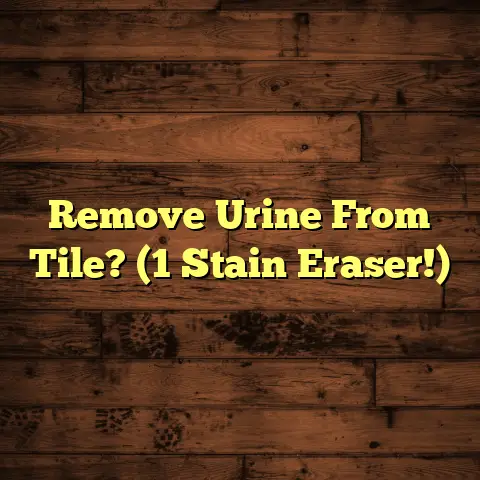Clean Porcelain Tile: Pro Strategies? (1 Cleaning Hack)
A lot of that feeling comes from the floors, especially when they’re sparkling porcelain tile. I’ve seen it time and time again.
A homeowner, let’s call her Sarah, was at her wit’s end. Her once-gleaming porcelain tiles had become dull, stained, and just plain depressing.
Sound familiar?
She’d tried everything – store- bought cleaners, steam mops, you name it. Nothing seemed to truly restore that original shine.
Then, she stumbled upon a cleaning hack (which I’m about to share!).
The transformation was incredible. The dull, grimy surfaces morphed into gleaming, pristine tiles that reflected light and breathed new life into her home.
Trust me, the emotional impact of a clean space is HUGE. It can lift your spirits, boost your mood, and create a welcoming environment for family and friends.
Ready to ditch the dingy and embrace the dazzling? Let’s dive in!
Section 1: Understanding Porcelain Tile
Porcelain tile is a rockstar in the flooring world, and for good reason.
I’ve installed miles of it over the years. It’s known for its durability, water resistance, and versatility. You see it everywhere – kitchens, bathrooms, hallways, even outdoor patios.
But what is porcelain tile, exactly?
It’s a type of ceramic tile made from a refined clay and fired at super-high temperatures. This process makes it denser and less porous than standard ceramic tile.
That’s why it’s so tough and water-resistant.
Think of it like this: regular ceramic is like a sponge, while porcelain is more like a rock. Okay, maybe not that extreme, but you get the idea.
Glazed vs. Unglazed:
Now, let’s talk finishes. You’ve got two main types: glazed and unglazed.
-
Glazed: This type has a layer of liquid glass fired onto the surface. It’s more stain- resistant and comes in a ton of colors and patterns. It’s also generally easier to clean.
-
Unglazed: This is porcelain in its raw form. It’s more slip-resistant, which makes it a good choice for wet areas. However, it’s also more porous and can be trickier to clean because it can absorb stains more easily.
Common Challenges:
Even though porcelain is tough, it’s not invincible.
I’ve seen homeowners struggle with:
- Stains: Coffee spills, muddy paw prints, and even certain cleaning products can leave their mark.
- Grime Buildup: Over time, dirt and grime can accumulate, especially in textured tiles.
- Foot Traffic: High-traffic areas can become dull and worn down.
- Grout Issues: Grout is porous and can easily stain and discolor.
According to the Tile Council of North America (TCNA), regular cleaning is crucial to prevent long-term damage and maintain the appearance of your porcelain tile. (Source: TCNA Handbook)
Ignoring these challenges can lead to a sad state of affairs. Think dingy, discolored floors that detract from your home’s overall appeal.
That’s why knowing how to properly clean porcelain tile is essential.
Section 2: The Importance of Regular Maintenance
Think of your porcelain tile like your car. You wouldn’t wait until it’s completely covered in dirt and grime before washing it, right?
Same goes for your floors.
Regular maintenance is key to keeping them looking their best and preventing long-term damage.
Routine Cleaning:
So, what does “regular maintenance” actually mean?
It’s simpler than you think!
- Sweeping: Sweep or vacuum your porcelain tile floors at least once a week (more often in high-traffic areas). This removes loose dirt, dust, and debris that can scratch the surface over time.
- Mopping: Mop your floors weekly with a pH-neutral cleaner designed for porcelain tile. Avoid harsh chemicals or abrasive cleaners, as these can damage the finish.
- Spot Cleaning: Clean up spills immediately to prevent staining. Use a soft cloth and a mild cleaner.
Wear and Tear:
Neglecting your porcelain tile can lead to some serious problems down the road.
I’ve seen cases where homeowners who skipped regular cleaning ended up with:
- Permanent Staining: Stubborn stains that are impossible to remove.
- Dull Finish: Loss of shine and luster due to accumulated dirt and grime.
- Damaged Grout: Discolored, cracked, or crumbling grout.
According to a study by the Institute of Inspection, Cleaning and Restoration Certification (IICRC), floors that are not properly maintained can experience up to 50% more wear and tear over time. (Source: IICRC)
Visual and Health Benefits:
Beyond the aesthetic benefits, keeping your porcelain tile clean also has some important health benefits.
- Improved Air Quality: Clean floors reduce the amount of dust and allergens in the air, which can improve your indoor air quality.
- Healthier Environment: Regular cleaning helps to eliminate bacteria and germs that can thrive on dirty surfaces.
- Pleasant Living Space: Let’s face it, a clean home is just more enjoyable to live in.
Think about it: would you rather relax in a home with sparkling floors or one with dust bunnies and grime?
No brainer, right?
Section 3: The Ultimate Cleaning Hack
Alright, let’s get to the good stuff! I’m about to reveal my go-to cleaning hack for transforming dull, dirty porcelain tile into a gleaming masterpiece.
This hack is simple, effective, and uses ingredients you probably already have in your pantry.
Ready? Here it is:
The Baking Soda & Vinegar Power Wash
Yes, you heard me right.
Baking soda and vinegar – the dynamic duo of DIY cleaning.
I know what you’re thinking: “Vinegar? Won’t that smell?”
Don’t worry, the smell dissipates quickly, and the results are worth it.
Why This Works:
- Baking Soda: It’s a mild abrasive that helps to scrub away dirt and grime without scratching the tile.
- Vinegar: It’s an acid that helps to dissolve hard water stains and cut through grease.
- The Fizz: The reaction between baking soda and vinegar creates a fizzing action that helps to lift dirt and grime from the surface.
Materials Needed:
- 1 cup baking soda
- 1 cup white vinegar
- 1 gallon of hot water
- A large bucket
- A stiff-bristled scrub brush (or a grout brush for grout lines)
- A mop
- Clean towels
Preparation Steps:
- Clear the Area: Remove all furniture, rugs, and other obstacles from the area you plan to clean.
- Sweep or Vacuum: Thoroughly sweep or vacuum the floor to remove any loose dirt, dust, and debris.
- Pre-Treat Stains (Optional): If you have any stubborn stains, pre-treat them with a paste of baking soda and water. Apply the paste to the stain, let it sit for 15-20 minutes, and then scrub gently with a soft cloth.
The Cleaning Process:
- Mix the Solution: In a large bucket, combine the baking soda, vinegar, and hot water. Be prepared for some fizzing!
- Apply the Solution: Dip your mop into the cleaning solution and wring out the excess. Mop the floor in sections, making sure to cover the entire surface.
- Scrub the Grout: Use a stiff- bristled scrub brush (or a grout brush) to scrub the grout lines. Pay special attention to areas that are heavily stained or discolored.
- Let it Sit: Allow the cleaning solution to sit on the floor for 5-10 minutes. This will give the baking soda and vinegar time to work their magic.
- Scrub the Tiles: Using the scrub brush, scrub the tiles in a circular motion. Apply moderate pressure to remove any remaining dirt and grime.
- Rinse Thoroughly: Rinse the floor thoroughly with clean water. You may need to mop the floor several times to remove all traces of the cleaning solution.
- Dry the Floor: Use clean towels to dry the floor completely. You can also use a fan to speed up the drying process.
Post-Cleaning Care:
- Allow to Dry Completely: Make sure the floor is completely dry before replacing furniture or rugs.
- Apply Sealant (Optional): If you have unglazed porcelain tile, you may want to apply a sealant to help protect it from stains.
- Regular Maintenance: Continue to sweep and mop your floors regularly to maintain their shine.
Pro Tips:
- Test in an Inconspicuous Area: Before cleaning your entire floor, test the cleaning solution in a small, inconspicuous area to make sure it doesn’t damage the tile.
- Don’t Overdo the Vinegar: While vinegar is a great cleaning agent, too much can damage certain types of stone. Stick to the recommended amount in the recipe.
- Use Hot Water: Hot water helps to dissolve dirt and grime more effectively.
- Don’t Be Afraid to Scrub: Don’t be afraid to put some elbow grease into scrubbing the tiles and grout lines.
- Consider a Steam Mop: For a deeper clean, you can use a steam mop after scrubbing the floor.
Section 4: Common Mistakes to Avoid
Okay, so you’re armed with my ultimate cleaning hack. But before you go wild with the baking soda and vinegar, let’s talk about some common mistakes I see homeowners make when cleaning porcelain tile.
Avoiding these pitfalls will ensure you get the best results without damaging your floors.
1. Using Abrasive Cleaners:
This is a big one.
I’ve seen homeowners use abrasive cleaners like scouring powders or steel wool pads on their porcelain tile, thinking they’re getting a deeper clean.
Big mistake!
These types of cleaners can scratch the surface of the tile, leaving it dull and damaged.
Always use a pH-neutral cleaner specifically designed for porcelain tile.
2. Neglecting Grout Lines:
Grout is porous and can easily stain and discolor if not properly cleaned.
I’ve seen grout lines turn yellow, brown, or even black over time due to accumulated dirt and grime.
Make sure to scrub your grout lines regularly with a grout brush and a good grout cleaner.
3. Using Too Much Water:
While porcelain tile is water- resistant, too much water can seep into the grout lines and cause problems.
Always wring out your mop thoroughly before mopping the floor. You want the floor to be damp, not soaking wet.
4. Not Rinsing Properly:
Failing to rinse the floor thoroughly after cleaning can leave behind a residue that attracts dirt and grime.
Always rinse the floor several times with clean water to remove all traces of the cleaning solution.
5. Using the Wrong Tools:
Using the wrong tools can also damage your porcelain tile.
Avoid using stiff-bristled brushes or abrasive pads on the tile surface.
Instead, use a soft cloth, a sponge mop, or a microfiber mop.
6. Ignoring the Manufacturer’s Instructions:
Every type of porcelain tile is different, and some may require special cleaning methods.
Always read the manufacturer’s instructions before cleaning your tile.
Anecdote Time:
I once had a client who tried to clean her porcelain tile floors with a mixture of bleach and ammonia.
Yikes!
Not only is this combination dangerous (it creates toxic fumes), but it can also damage the tile and grout.
She ended up with discolored grout and a lingering chemical smell that took weeks to get rid of.
Learn from her mistake and always use safe and appropriate cleaning methods.
Conclusion
So, there you have it – my ultimate cleaning hack for transforming your dull, dirty porcelain tile into a gleaming masterpiece.
It’s simple, effective, and uses ingredients you probably already have in your pantry.
But more than just cleaning your floors, this hack can transform the entire atmosphere of your home.
Remember Sarah, from the beginning? The woman who was at her wit’s end with her dull, stained tiles?
After using this cleaning hack, her home felt brighter, cleaner, and more inviting.
She even told me that she felt a sense of accomplishment and pride in her home.
And that’s what it’s all about, right?
Creating a space that you love and that makes you feel good.
So, go ahead and give this cleaning hack a try.
I promise you won’t be disappointed.
Embrace the joy of a clean space and the sense of accomplishment that comes with maintaining your porcelain flooring.
You got this!





